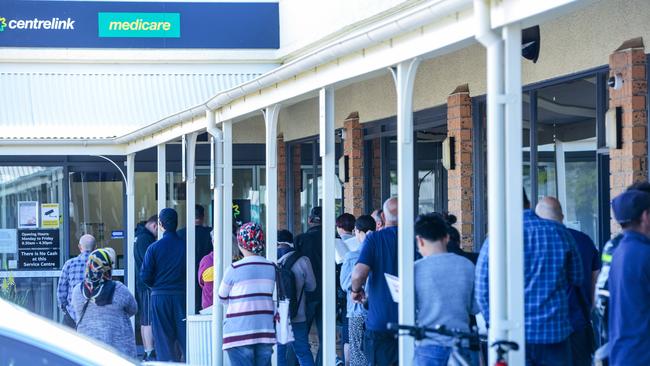Jobseeker approval data shows coronavirus has hit wealthy areas across South Australia
Almost 48,000 South Australians lost their jobs during the coronavirus lockdown, official data has shown. We have a suburb by suburb, town by town breakdown. VIEW IT HERE

Local
Don't miss out on the headlines from Local. Followed categories will be added to My News.
- Thousands forced to queue out Centrelink for dole applications
- Today: Elective surgery backlog reduces
- How to make the most out of your Advertiser subscription
Coronavirus has hit some of the state’s wealthiest areas the hardest, with one recording an increase in unemployment of more than 200 per cent.
The impact of the recent three-month lockdown has become evident in Commonwealth Government data comparing the amount of people receiving the Jobseeker unemployment benefit between March and May.
In South Australia, the number of people receiving the dole increased from 78,421 to 126,375 in three months - a total of 47,954.
Queues resembling the Great Depression formed outside Centrelink offices across metropolitan Adelaide at the beginning of the COVID-19 crisis as thousands suddenly found themselves out of work.
While joblessness has remained relatively static in areas of traditional unemployment such as Adelaide’s northern suburbs, affluent areas with numerous retail outlets, cafes and hotels have seen startling numbers of residents lose their jobs.

Toorak Gardens, Norwood, St Peters, Marden, Burnside, Unley, Parkside, Goodwood, Millswood, Glenside, Mitcham, Walkerville, Henley Beach, Rostrevor and Magill have recorded increases in Jobseeker approvals of between 118 per cent and 181 per cent.
The worst hit part of the state has been North Adelaide at 213 per cent, followed by Belair (196 per cent).
By contrast, suburbs such as Munno Para West, Gawler South, Craigmore, Blakeview, Salisbury, Hackham, Onkaparinga Hills and Christies Beach recorded increases of between 31 and 67 per cent.
Elizabeth was the lowest in the state, with only an extra 17 per cent increase in those seeking the dole.
Other areas with higher unemployment included those in the Adelaide Hills with wineries and tourist facilities, such as Hahndorf (113 per cent) and Aldgate and Stirling (147 per cent).
The Barossa Valley, which was isolated following an outbreak linked to the Ruby Princess cruise ship, also suffered with Nuriootpa recording an 107 per cent increase and Lyndoch 98 per cent while further south the wine region of McLaren Vale experienced 91 per cent.
Regional areas have not escaped, with fire-ravaged Kangaroo Island being among the hardest hit at 90 per cent while the two South East crayfishing ports, Robe and Kingston, had 116 per cent after being hit by export bans.
Respected former State Bank economist Darryl Gobbett said it was not surprising there had been the bigger increase in JobSeeker claims in wealthier suburbs which traditionally have had low unemployment.
“This reflects the shut down of the cafes, restaurants, theatres, travel agents, child care centres, event management and elective health-care that would employ more locals in these suburbs that in the higher unemployment suburbs,” he said.

Mr Gobbett is examining the impact of the COVID-19 crisis on employment for the University of Adelaide’s SA Centre for Economic Studies.
“These job losses and shutdowns would also likely have a relatively bigger impact on young locals often working as part time or casuals while studying, than would be the case in the higher unemployment and lower income suburbs,” he said.
“These younger workers, compared to older, full time workers in these wealthier suburbs, may have had less support from JobKeeper benefits and so had to move to JobSeeker.
“This may also have been impacted by tertiary study also being put on hold”.
Mr Gobbett said it was also likely that small businesses within higher income suburbs had been hit harder by job losses a result of travel shutdowns affecting fly-in, fly-out workers and professional services commuters who dealt with interstate clients.

